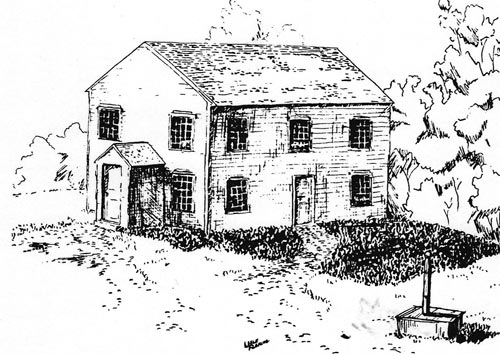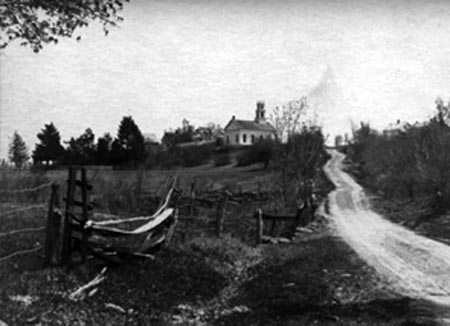|
|
||||||||||||
 |
 |
|
Wolcott Historical Society News - May 2011 By Florence Goodman Last month's article introduced you to the 150th Anniversary of the Civil War in our country. This War affected people in many ways whether you lived in the North or the South, small town or large city. The actions of the abolitionists that led up to the actual fighting in 1861 were felt long before that date, even in our newly established town of Wolcott. In this edition, I will discuss an incident in town that may have been caused because of those differences of opinions.
The original Meeting House on the Green was completed in 1773 and during those early years there were numerous ministers who served the Society, but Reverend James D. Chapman's ministry, which began in 1837 when the anti-slavery spirit was on the rise, was one of the most turbulent. Reverend Chapman was a strong anti-slavery proponent and his feelings were apparent in his preaching. Yankee farmers did not understand the need for the slaves used on southern plantations because northern farms were smaller and were worked by family members; and there were few blacks living in this area at that time. Interesting enough, there were only three references to blacks in the original Farmingbury Parish records and John Washburne states, "they were Pittee - a negro woman who died May 1, 1804 at the age of 74, Harry, a youth of color, baptized November 4, 1822 and brought for baptism by the wife of David R. Upson, and Cambridge - a negro, died October 22, 1782."
Not all church members were of the same belief as the Reverend and Wolcott was strongly a democratic town. Consequently, in 1839, a committee was appointed to discuss the removal of the minister from his pastorate. Some members were so enraged over the Reverend's stand that they tried to intimidate him and his supporters by shearing the manes and tails off their horses, and a cow belonging to one member who did not have a horse.
Another situation that was causing opposition in the Parish was the installation of a new wood stove that had been put in the Meeting House. The new stove replaced an old one installed in 1815 and used until 1829 when it was put aside. This new stove had been installed in November of 1839, but many members did not see its need so tension over the stove, as well as, the anti-slavery issues continued to build in the church and Society.
This situation came to a head on December 11, 1839, when the Meeting House burned to the ground. Reverend Chapman had scheduled an anti-slavery meeting to be held at the church on December 12th, but the night before, someone had placed a quantity of gunpowder with a slow wick in the stove. Around 9:00 P.M., residents around the church heard a small explosion, but did not know where it had occurred. Around midnight, the church was engulfed in flames and quickly burned to the ground.
The next day, Reverend Chapman and his supporters held their meeting on the subject of freedom around the smoldering ashes of the church. Whether the motive for this deed was anti-slavery and freedom issues or dismay over the new stove was not known, but several people were arrested for the misdeed. There was a witness, who was well known in the town, but when the trial date was set, the witness had left town; thus no trial was held due to lack of evidence. It was said that the witness had been told that if he testified, he would be killed.
On April 26, 1840, at the annual meeting of the First Society, seventeen anti-slavery men withdrew from the Society to show their support of the Reverend Chapman. Included in this group was Deacon Isaac Bronson, who had been a lay preacher in the church for five years. After the men withdrew, the Society immediately voted to notify Reverend Chapman that, "they wish that the pastoral relation may be dissolved between him and this Society agreeably to the contract entered into between him and this Church and the Society at the time of his settlement," stated Samuel Orcutt.
On July 10, 1840, a Second Congregational Society of Wolcott was organized consisting of those members who had left the First Society. Attempts were made by the First Society to lure the Second Society back into the original church, but this was unsuccessful. A Consociation met to discuss this problem on November 9, 1840. This meeting resulted in the dismissal of Reverend James D. Chapman. Thus, Reverend Chapman gave up his position and the two Societies were combined into one again, allowing the process of rebuilding their church physically and emotionally to begin.
It is obvious that the same issues that caused our countrymen nationally to take up arms against each other created a reaction even in our small town of Wolcott.
(Information for this article was taken from The History of Wolcott, Connecticut from 1731 to 1874 by Reverend Samuel Orcutt, The Meeting House Atop of Benson's Hill by John Washburne, and The Wolcott Congregational Church 1773-1948 by Rose E. Wakelee).
SAVE THE DATE: June 11th is Connecticut Open House Day and the Schoolhouse Museum is part of this state event. Our Museum on Nichols Road will be open from 9 AM to 3 PMM. Admission is free. Antique Appraiser Carl Hotkowski will be on hand to do one free antique appraisal for each visitor. We will also be hosting a Tag Sale outside.
Our Schoolhouse Museum is open by appointment only; you may visit the Museum by calling Loretta Leonard at 203-879-4310 or Flo Goodman at 203-879-9818. Our meetings are held on the first Thursday of each month at the Old Stone School on Nichols Road at 6:30 P.M. unless snow cancels them in the winter season.
Original Meeting House, Etching by Lisle Fleming. The siding of the Congregational Church was clapboard and originally painted white with a red chestnut shingle roof. The 48-foot long and 36-foot wide structure was built in 1772-3. It was destroyed by fire in 1839. Joseph Atkins gave the two-acre site for the building on June 8, 1772. (Note the whipping post in the side yard.)
The second Meeting House was finished on January 18, 1843. This is a view of the Congregational Church from the bottom of Center Street at the intersection of Wolcott Road..
To view past installments of the Wolcott Historical Society News, click here.
|
|
|
[Home]
[News]
[Purpose]
[Calendar]
[Museum]
[Membership]
[History]
[Contacts]
[Links]
All material at Wolcott Historical Society Web sites Copyright © 2000-2011 Wolcott Historical Society |

